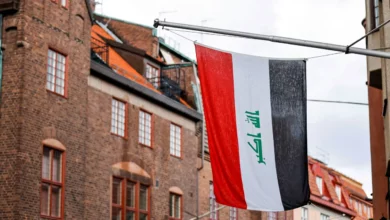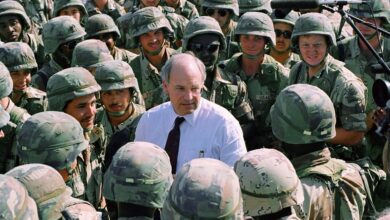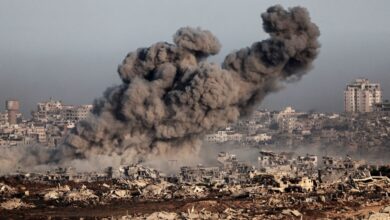The story of Iraq on the 10th anniversary of the second US invasion is composed of a series of tragedies.
The first tragedy is the sacrificing of truth at the altar of war.
It began with the massive media desensitization of the suffering of the Iraqi people during 13 years of United Nations sanctions, the most punitive measures ever imposed against a nation in human history. By 1996, the UN estimated that 500,000 Iraqi children had died due to the sanctions regimen, a price that the then-US ambassador to the UN said was worth paying to corner Saddam Hussein.
The sanctions not only caused deaths — 1.7 million by 2003, the UN says — but deprived Iraqis of the most basic medicines and nutritional necessities.
By the time the US invaded Iraq, its society had already been devastated by the sanctions. The Iraqi army was starved for spare parts, domestic infrastructure was in disrepair and required billions, and Iraqi hospitals were emptied of vital medicines — specifically those to combat cancers.
The Iraqi middle class was wiped out. Extreme poverty and illiteracy settled in.
Over the next nine years, Iraq would be looted, destroyed, vandalized and systematically torn apart. Billions of dollars would go missing, the National Archives would be gutted, and advanced scientific research facilities looted and burned. Reconstruction would be a cover word for theft of funds.
Hundreds of Iraqi scientists, technicians, lawyers, writers and artists were killed in targeted assassinations. The Brussels Tribunal says at least 450 academics alone were killed in the past decade.
According to the UN, there have been more than 30,000 attacks against educational institutions in Iraq between 2003 and 2010. The Arab world’s most advanced education system, which in the 1970s and 1980s graduated a highly skilled workforce, was laid to ruin. More than 20,000 Iraqi physicians fled the country in what would become the greatest refugee crisis in Arab history. By 2008, 2.5 million Iraqis had fled to neighboring countries; another 2 million were internally displaced.
For those who were unlucky to stay, life was hell. By 2006, when Shia and Sunni militias were at war, Iraqis feared death by kidnapping, hit squads, US raids and at checkpoints.
On 9 August 2003, for example, a man and his three children — the youngest just eight — were killed when US forces fired on their vehicle after hearing gunfire nearby the Tunis district of Baghdad. The mother and surviving daughter screamed at US soldiers to stop, that they were a family, but the firing continued.
The mother later said they were not speeding and were driving very slowly up to a checkpoint so as to not alarm the Americans. This would be one of hundreds of incidents repeated until Iraqi troops started manning checkpoints.
Thousands of Iraqi men and women were tortured, some to death, in numerous prison camps that many had never heard of. Some of these camps were run by the Iraqi rulers and their militia. Thousands of Iraqis disappeared. Abu Ghraib, a US-run prison, produced its own horror stories and has proved to be an eternal taint on US military history. Today, it is still being used for systemic torture and executions by the new Iraqi government.
Since 2003, several US service men and women have been put on trial or court-martialed for murder, rape, sodomy, perjury, tampering with the scene of the crime, conspiracy, planting weapons on Iraqi victims, torture, theft and other improper acts committed against Iraqis.
Except for Charles Graner and Lynndie England, sentenced to 10 years and three years in prison, respectively, for the Abu Ghraib scandal (nine others received dereliction of duty sentences, demotions, etc.), and the life sentences handed down in the rape and incineration of 14-year-old Abeer Janabi in Mahmoudiya, most trials end in suspended sentences or were dismissed for insufficient evidence or other technicalities.
The Telegraph’s Sean Rayment interviewed a British officer who said he believed the US approach to Iraqis was to treat them as “untermenschen,” the Nazi term abhorrently used to describe Jews as “subhuman.”
But most of these stories remain untold.
Take, for example, the great agricultural damage that Iraq sustained in the past 10 years: Citing security issues, US troops have cut down precious date trees — often the life-sustaining source of many Iraqi villages — burned and razed crops, agricultural yields and fields, drained swamps, and burned grassy knolls where it is alleged that Iraqi “terrorists” were hiding.
The first tragedy continued as US coverage of what was really happening in Iraq was heavily sanitized. It was also heavily biased because of embedded reporting — a concept drafted by the US military to avoid embarrassing coverage such as that of dead and wounded US personnel in Vietnam.
When an online portal I worked for — Yellowtimes.org — published pictures of Iraqi children killed by US troops, it was immediately suspended and taken offline, not by the US government or a regulatory body, but by the Internet Service Provider.
The second tragedy began almost as early as the first. With the “Mission Accomplished” banner atop a US aircraft carrier and the toppling of the Saddam Hussein statue, many US networks began to scale back coverage. There would be a gradual disinterest in Iraq as the years wound down to the eventual US withdrawal.
The sociopolitical and economic mess the US left in the wake of its war of liberation receives little in-depth press, as do the political undercurrents and Iran’s influence in Iraq. Today, there are daily protests against the government of Prime Minister Nouri al-Maliki, with some accusing him of running Iraq like a dictator.
Serious divisions between the Sunnis, Shia and Kurds threaten to tear Iraq apart.
While violence has fallen sharply in Iraq — a phrase that US media love to use — there are nearly daily attacks on civilians, the military, and the police and government institutions. Every year since US soldiers began pulling out of Iraq in 2009, there have been between 5,000 and 7,000 fatalities, and another 50,000 injured or wounded in attacks.
In conservative estimates, 134,000 Iraqis have died since 19 March 2003, according to Iraq Body Count. Other estimates, such as one by the medical journal The Lancet, put the figure at 1.4 million dead Iraqis.
And then there is Fallujah, a city twice attacked by US forces and subjected to the use of white phosphorus. These types of munitions, including depleted uranium, have left its population poisoned and having to bear the effects of what some are calling “the most severe health crisis in history.”
Cancer rates, infant mortality rates and birth defect rates have all soared since the war of liberation. Chris Busby, the author and co-author of two studies on the Fallujah heath crisis, is quoted in The Guardian as calling it “the highest rate of genetic damage in any population ever studied.”
And this is the third tragedy: Iraqis have not only been ignored by the international community, but forgotten by their own Arab brethren.
Ten years later, a majority of Iraqis are dependent on the rationing system — a national welfare and food assistance program established by Saddam Hussein in the 1990s.
Ten years later, the reasons for going to war — weapons of mass destruction and Al-Qaeda links to the Iraqi regime — turned out to be entirely unfounded.
Ten years later, the story of Iraqi suffering remains incomplete.




